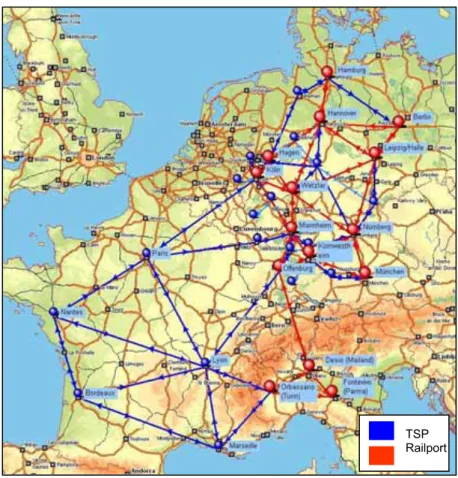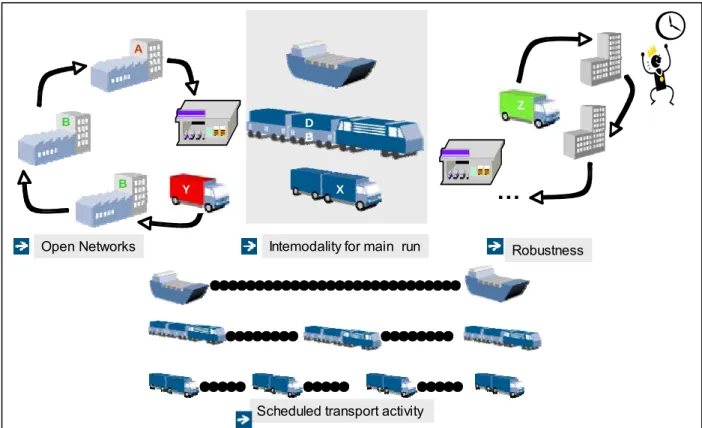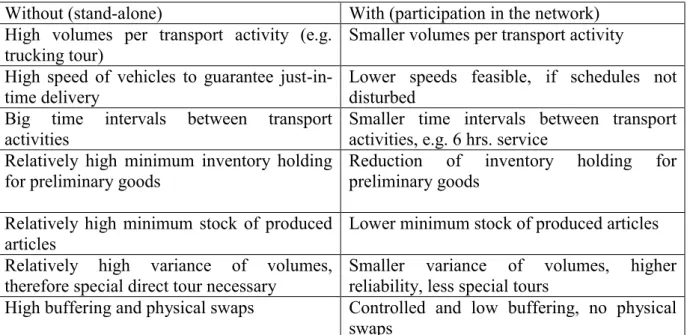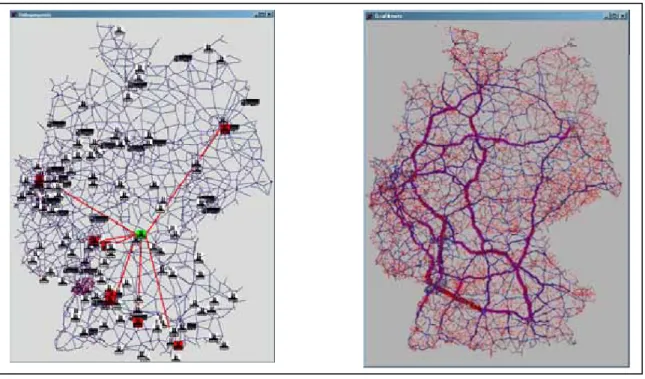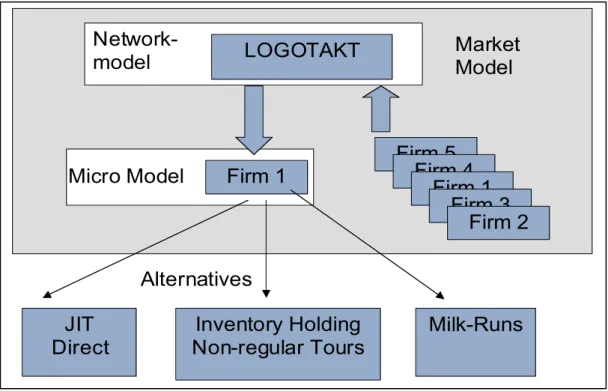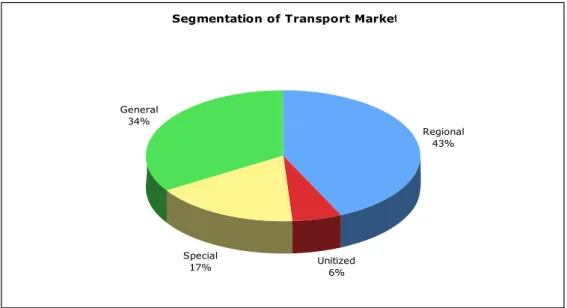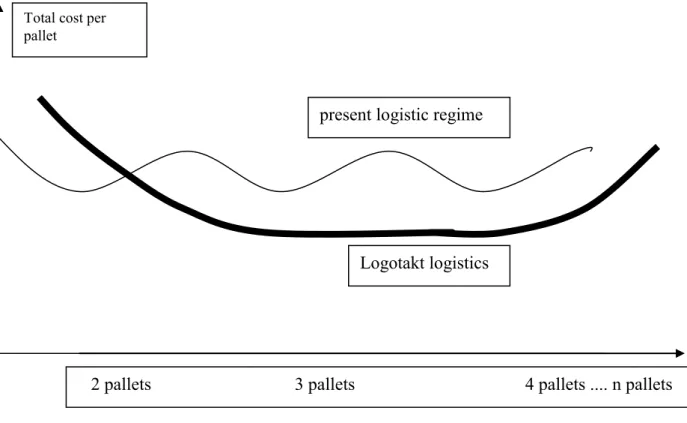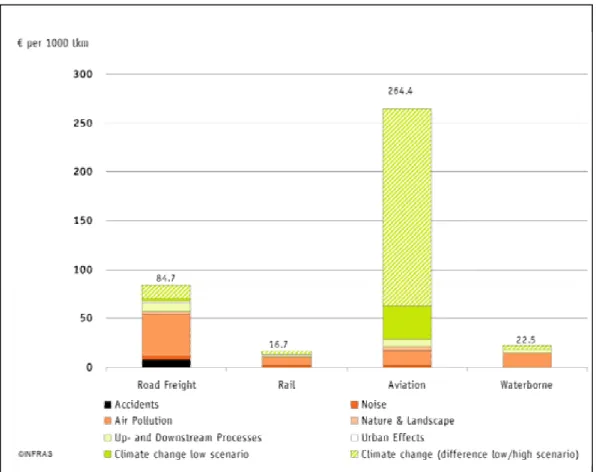The First International Conference on Research Opportunities in Transport and Logistics at the Regional Level: A Global Perspective February 2009 øVWDQEXO / (GLWHGE\g]D\g]D\GÕQ² 1. This shows that transport and logistics are the most promising industries for the world economy.
Potential to Reduce GHG through Efficient Logistic Concepts
In recent years, just-in-time delivery has dominated shippers' logistical needs. At the end of the day, the participation in the virtual moving platform must be profitable for the companies.
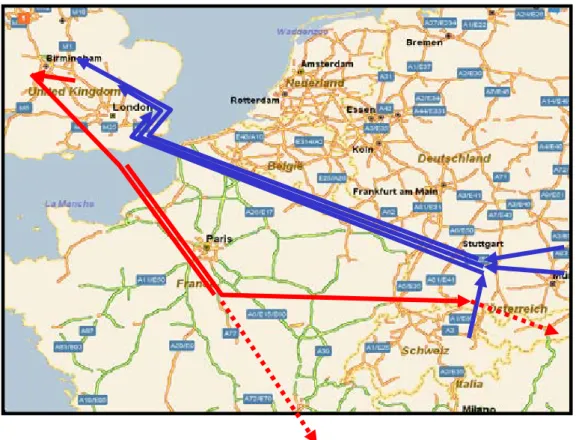
JIT Direct
Firm 1
So far, such micro-macro modeling has only been possible for around 60% of freight transport activities in Germany.
Firm 2
With these limitations for the interpretation of the figures in mind, one can derive the following results:. For the firms analyzed, the saving of external costs can be calculated on the basis of the Handbook (CE et al, 2008) for marginal costs or of the study FACORA of Infras/IWW (2004) for average costs.
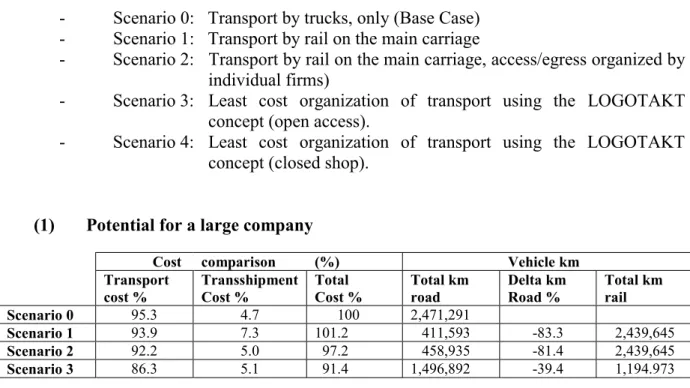
A METHODOLOGICAL FRAMEWORK FOR THE EVALUATION AND PRIORITISATION OF MULTINATIONAL TRANSPORT PROJECTS: THE
CASE OF EURO-ASIAN TRANSPORT LINKAGES
Promote solutions to the special transit transport needs of the landlocked developing countries; (CA2) - Connect low-income and/or least developed countries to major European and Asian markets; (CA3). To what extent will the project promote solutions to the special transit transport needs in landlocked developing countries (criterion CA2).
CONTAINER PORT THROUGHPUT PERFORMANCE – CASE STUDY
FAR EAST, NORTH WEST EUROPEAN AND MEDITERRANEAN PORTS
- INTRODUCTION
- WORLD LEADING CONTAINER PORTS THROUGHPUT
- Far East Ports
- European ports
- Mediterranean ports
- COMPARISONS OF PRODUCTIVITY BETWEEN SELECTED REGIONS
- COMPARISONS OF PRODUCTIVITY BETWEEN SELECTED PORTS
- CONCLUSIONS
The TEU per hectare and TEU per berth meter of major European and Far East ports [4]. The TEU per hectare and TEU per berth meter of the FE, NWE and CIG-E ports/terminals.
LOGISTICS SERVICE PROVIDERS IN TURKEY
A PANEL DATA ANALYSIS
In the literature, outsourcing has been identified as one of the most important components of 'flexible'. Competition in the logistics sector is increasing, forcing 3PLs to provide a limited number of services.
MILESTONES IN THE PROCESS OF SURVEY PREPARATION FOR THE LOGISTICS SECTOR: CASE STUDY FOR ISTANBUL, TURKEY
- Reasoning of the Study
- Purpose of the Study
- Methodology
- Scope
- STUDY DESIGN
- Analysis of the Logistics System: Actors of the System
- Sampling Frame: Determination of Populations and Samples
- Survey Design
- Difficulties Observed During the Study
- Solutions for Successful Designs
- CONCLUSIONS AND RECOMMENDATIONS FOR FUTURE RESEARCH This paper summarized the purpose, scope, methodology, and stages of the study of logistics and
Roadside interception surveys for all vehicles at major remote stations (highway and expressway sites) of the study area. Considering different types of actors, two approaches were considered for the design of the survey questionnaires.
EDUCATION IN TRANSPORT AND LOGISTICS IN AN AGE OF GLOBAL ECONOMY
- WORLD ECONOMY AT THE THRESHOLD OF NEW MILLENNIUM
- PROSPECTS FOR THE FUTURE: ECONOMIC TRANSFORMATION
- KNOWLEDGE ECONOMY AND THE HIGHER EDUCATION SYSTEM
- THE ROLE OF TRANSPORT AND LOGISTICS NETWORKS IN THE NEW ECONOMY
- HIGHER EDUCATION IN PROMOTING THE EFFICIENT TRANSPORT &
- WHAT SHOULD BE IN THE AGENDA FOR THE FUTURE?
As the new millennium dawns, the roles assigned to science seem to be changing. 10 Commission of the European Communities, The Role of Universities in the Europe of Knowledge.
THE ROLE OF EDUCATION AND TRAINING IN THE SUPPLY CHAIN SECTOR
- AIMS AND OBJECTIVES
- INTERNATIONAL ORGANISATION
- MEMBERSHIP GRADES OF CILT There are four membership grades namely
- EDUCATION AND TRAINING
- THE INTERNATIONAL CERTIFICATE IN LOGISTICS AND TRANSPORT
- THE INTERNATIONAL DIPLOMA IN LOGISTICS AND TRANSPORT
- THE INTERNATIONAL ADVANCED DIPLOMA IN LOGISTICS AND TRANSPORT This advanced course which is the equivalent of a degree is primarily aimed at developing strategic
- CONCLUSIONS
The scholarship is reserved for those who hold positions of high responsibility in the logistics and transport sector. This qualification is designed for supervisors and front line managers working in the logistics and transport industry. Membership provides a professional identity and international recognition for those already employed in the logistics and transport sector.
MODELING REVERSE FLOWS IN A CLOSED –LOOP SUPPLY CHAIN NETWORK
In Section 3, we introduce a closed loop supply chain (CLSC) structure and material flows within it. Closed Loop Supply Chain (CLSC) practices, reusable product environments, and the design of these products and materials have become an increasingly important segment of the industry's overall push toward environmentally conscious manufacturing and logistics [Zhu, Sarkis, and Lai, 2008]. Total transportation costs can be calculated by summing all transportation costs related to all closed-loop supply chains.
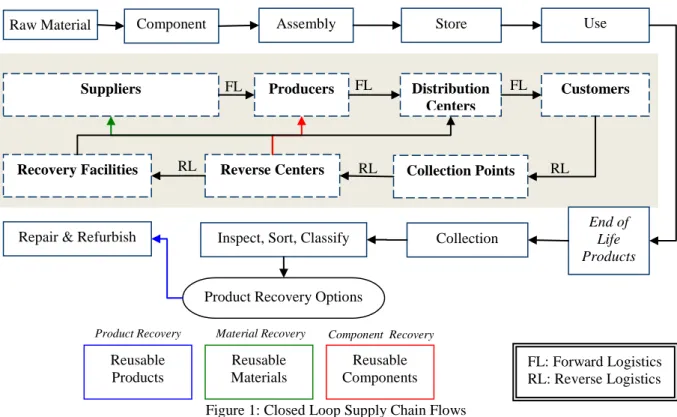
STRATEGIC ANALYSIS OF GREEN SUPPLY CHAIN MANAGEMENT PRACTICES IN TURKISH AUTOMOTIVE INDUSTRY
In the framework, alternative 1 (ALT1) is identified as JIT (Just in Time), alternative 2 (ALT2) as environment-focused supply chain management, and alternative 3 (ALT3) as the current SCM system of the case company. In the framework, the current supply chain systems of the case companies are compared with two other alternatives (ALT1 and ALT2). The final step in the process is to obtain a priority order for each of the alternatives.
A NEW FRAMEWORK FOR PORT COMPETITIVENESS: THE NETWORK APPROACH
The model used [17] was based on the assumption that better integration between port actors leads to greater competitiveness of the supply chain. The concept of interconnection instead refers to the position of a port within intermodal routes [19]. In this way, the characteristics of the supply chain play a key role in defining port development.
CLEAN TRANSPORT: INNOVATIVE SOLUTIONS TO THE CREATION OF A MORE SUSTAINABLE URBAN TRANSPORT SYSTEM
The introduction of public transport vehicles that run on alternative "green" fuels is one of the most important areas for intervention in the creation of sustainable urban transport. New subways, light rail and tram systems have been introduced in many cities, not only in Europe, but in all parts of the world. Two of the city center's main boulevards have been assigned to the tram system, and are therefore closed to motorized traffic.
EFFECTS OF URBAN BOTTLENECKS ON HIGHWAY TRAFFIC CONGESTION: CASE STUDY OF ISTANBUL, TURKEY
METHODOLOGY
- Data Collection
- Bottlenecks
A compact sedan car is started to collect travel times at different time periods between major junctions and junctions, and then the speed is calculated based on the distances obtained from the highway network, as shown in Figure 2. A view of the Excel sheet created to facilitate the management of data collection is shown in Figure 3. In the middle of the city there are two large bottlenecks connecting one side to the other; namely Bogazici Bridge (Bosphorus) and Fatih Sultan Mehmet (FSM).
DATA ANALYSIS AND RESULTS 1. Major Bottlenecks
- Temporary Bottlenecks 1. Lane Drop/Shift Due to Construction
- New Bridge Construction on Westbound Highway D100 (E-5) A lane drop/shift 1300 m after Pendik Interchange on westbound Highway D100 (E-5) between Pendik and Kartal interchanges
- Repavement on Northbound Beykoz Shore Road (Minor Arterial) A lane drop on northbound Beykoz Shore Road caused a significant decrease in travel speed. Speeds observed on the
- Westbound Highway D100 (E-5) at Maltepe Interchange An accident on westbound Highway D100 (E-5) located 800 m after Maltepe Interchange resulted a decrease of 94.4% in travel
This means that as the speed decreases to 16 km/h, the travel time increases by 4 times upstream. The incident (capacity reduction due to Gulsuyu interchange reconstruction) on the westbound D100 (E-5) freeway resulted in upstream speed and travel time indices of 0.25 and 4.06, respectively. This means that as the speed decreases to 6 km/h, the travel time increases by 4.83 times upstream of the incident location.
SUMMARY AND CONCLUSIONS
The driving speed index is equal to the upstream speed divided by the downstream speed on the section. Travel Time Index is equal to the downstream speed divided by the upstream speed on the stretch. The incident (accident) on highway D100 (E-5) westbound at Maltepe Intersection resulted in the upstream travel speed and travel time indices of 0.056 and 17.8, respectively.
ESTABLISHING AN EFFECTIVE TRAINING MODULE FOR IMDG CODE IN MET INSTITUTIONS
- Gases
- Flammable Liquids
- Flammable solids; substances liable to spontaneous combustion; substances which, on contact with water, emit flammable gases
- Oxidizing substances and organic peroxides Division 5.1 Oxidizing substances
- Corrosive substances
- Miscellaneous dangerous substances and articles*
Substances and articles which present a fire hazard and a minor explosion hazard or a minor projection hazard, or both, but do not have a mass explosion hazard. The training design has enough details to evaluate the training module against the established criteria. The IMDG training module consists of three levels, which are explained accordingly in the subsequent subsections.
Theoretical Aspects
2 Jetty, of SemLogisticsterminal, Milford Haven, when the master suddenly and without warning lost control of the vessel's suspended propulsion system [13]. This caused the vessel to come into contact with the dock's infrastructure, resulting in material damage to both the dock and the vessel before control was regained. The IMDG Code is accepted as an international guideline for the transport of dangerous goods by sea and is recommended to governments for adoption or for use as a basis for national regulations.
Rule-based Shipboard Implementations
The lack of internal maintenance procedures, insufficient system knowledge by ship officers and shore personnel, and poor Safety Management System (SMS) and on-board system documentation, superimposed on a propulsion system for which, at the time, no dedicated technical standards existed, resulted in a vessel whose resistance to defects and emergencies is significantly weakened, are the reasons for this accident. In both two accidents the reasons, especially regarding the human errors and technical failures based on lack of maintenance [13]. At that stage at this level, the regulatory basis of IMDG code is introduced, regulations regarding the transport of dangerous goods are extracted and analyzed and then try to acquire effective problem-solving and decision-making abilities in limited times to trainees with the implementation of correct rules.
Health and Safety Precautions in Operational Level
AN INVESTMENT DECISION AID PROPOSAL TOWARDS CHOICE OF CONTAINER TERMINAL OPERATING SYSTEMS BASED ON
INFORMATION AXIOMS
The information axioms decision methodology requires making judgments about alternative operating system expectations in terms of identifying the IFR values. In addition, the judgments of the two different experts on alternative operating systems are presented in Table 3 and Table 4. The advantage of the proposed IA-based methodology appears to be mainly the definition of IFR values to express the expectations and preferences of a terminal operating company. printing systems.

POSSIBILISTIC LINEAR PROGRAMMING APPROACH FOR STRATEGIC RESOURCE PLANNING
For this reason, an additional objective is defined to minimize the ambiguity of the profit. The concept of entropy is used to measure the obscurity of the fuzzy sets and numbers. Initially, the following LP model is proposed to find the upper and lower bounds of the profit.

A STRUCTURAL EQUATION MODEL FOR MEASURING SERVICE QUALITY IN PASSENGER TRANSPORTATION
As confirmed in Figure 2, quality of service has a direct effect on customer satisfaction (0.94), so H3 is confirmed. Finally, service quality has direct effects on service value, customer satisfaction and customer loyalty. In airline services, the quality and service value of all airlines influences customer loyalty.
ANALYSIS OF POTENTIAL GAIN FROM USING HYBRID VEHICLES IN PUBLIC TRANSPORTATION
- INTRODUCTION
- EFFECTS OF PT ON ENVIRONMENT
- NEXT STEP: HYBRID VEHICLES
- HYBRID VEHICLES AS A PUBLIC TRANSPORTATION TOOL
- RESULTS
By recovering 50% of the total kinetic energy (25% of the total energy consumed), fuel consumption is increased by 33%. Power is transmitted to the wheels electrically through a combination of the engine generator set and traction batteries. Here we will try to provide an understanding of the cost factors associated with owning and operating hybrid electric buses.
![TABLE 1 - SERIES HYBRID [1]](https://thumb-eu.123doks.com/thumbv2/123dok_br/17602394.4189794/144.892.149.746.679.975/table-series-hybrid.webp)
OPTIMIZATION OF E-WASTE MANAGEMENT IN MARMARA REGION - TURKEY
One is the cost of transportation based on the distance traveled and the other is based on the duration of the trip. The modeling results, total costs and selected split stations are summarized in Table 1. Furthermore, traffic congestion is not considered for hourly route duration while calculating the transportation cost.
FUTURE PROSPECTS ON URBAN LOGISTIC RESEARCH
Technological measures can provide important solutions for reducing the environmental footprint of urban logistics activities. A mainstream of research is therefore the development of techniques for collecting data on urban logistics activities. Another line of research concerns the integration of urban logistics activities with intercity logistics activities.
AN ANALYZE OF RELATIONSHIP BETWEEN CONTAINER SHIPS AND PORTS DEVELOPMENT
CONTAINER SHIPS DEVELOPMENT
The capacity of the world's container fleet is more than 10 million TEU in operations and about 3.0 million TEU on order in 2007 and 2008. According to the carrying capacity mobile ships participate with more than 75% in the structure of the world's container fleet. Also, the largest vessels currently on order have capacities of more than 12,000 TEU, and there is clearly room for even larger vessels.
WORLD CONTAINER PORTS DEVELOPMENT
Also, the container traffic of the world's 20 largest seaports from 1973 to 2006 is shown in Fig. ports grew on average by 25 percent, the growth did not reach last year's values.
AN ANALYSE OF RELATIONSHIP BETWEEN CONTAINERSHIP AND TRANSSHIPMENT HUB PORT
- Effect on container terminals development
Implementation of the presented procedure leads to the creation of a simulation algorithm and analytical methodology that properly captures the performance of the connection between ships and berths. Reasons for the decrease in the average cost per ship served with the introduction of new container berths, QCs, container yards and automated stacker cranes (ASC) include that ships' waiting time and average time spent in port are decreasing with the advanced handling systems improving operational procedures (see results of Figures 13, 14 and 15) [6, 7 and 8]. These achievements require the new ideas and concepts in container terminal planning to keep pace with the development of the mega container ships.
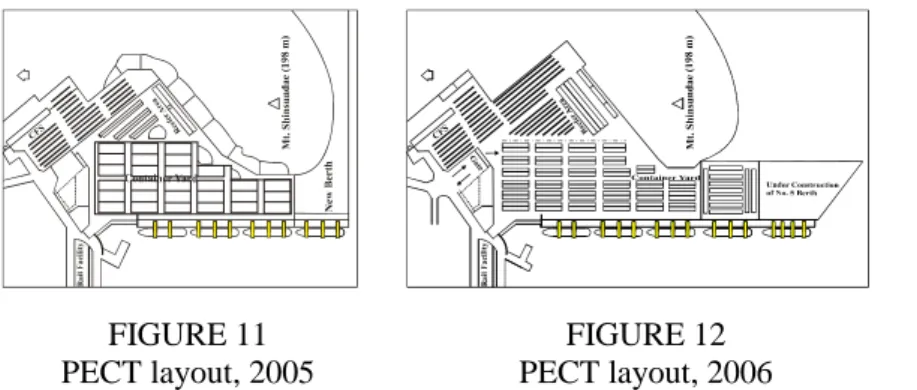
A HOLISTIC FRAMEWORK FOR PERFORMANCE MEASUREMENT IN LOGISTICS MANAGEMENT
THE PROCESS VIEW IN LOGISTICS AND SUPPLY CHAIN MANAGEMENT Process view is one of the key elements in logistics and supply chain management. According to
Performance measures are used to measure and improve the efficiency and quality of logistics processes, and to identify opportunities for progressive improvements in logistics process performance. It is crucial to use a balanced set of measures to understand process performance and identify areas for improvement. Based on this criteria sheet, the author of this article would argue that a number of measures can be used to improve the performance of the logistics processes (Table 1).
THE INTEGRATION OF OBJECTIVE MATRIX (OMAX): AN APPROACH IN DETERMINING THE PARTIAL AND OVERALL PERFORMANCE INDEXES OF
This means they can identify the company's current performance and potential for improvement. The top row of the matrix includes the KPIs that are assessed using the BSC approach and defined for each BSC perspective. The bottom of the target area is defined as the minimum level allowed.
L PPI
Possible results - intermediate values - of performance measures are found in the body of the matrix and are calculated for results between these ranges (Li). It will provide feedback on the effects of actions and ensure that strategic performance is continuously improved. We would argue that using the approach would increase the performance of logistics processes.
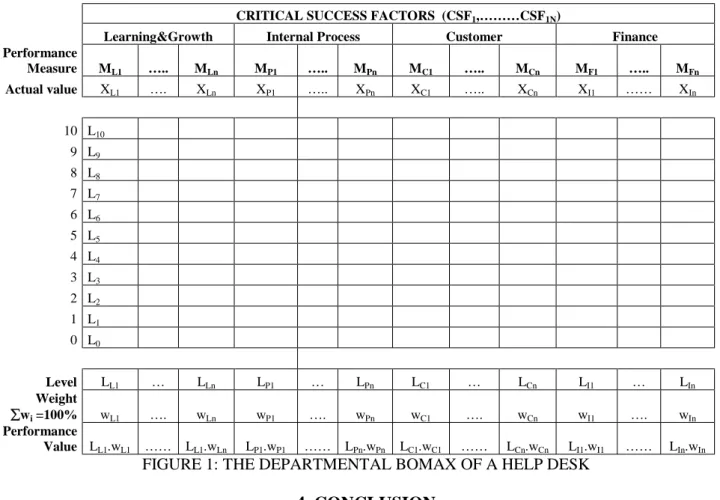
HEURISTICS FOR A GENERALIZATION OF TSP IN THE CONTEXT OF PCB ASSEMBLY
From the first point of the trip (the depot), travel costs for n1 points are calculated using C2(t1,x,y). AFP only applies when we can freely choose the first point of the trip. We observe that using only LCI or GI only increases performance by about 1.6% at about the same runtime.
TRAVELERS RESPONSE TO VMS IN THE ATHENS AREA
The following figure shows the respondents' feelings after obtaining VMS information. The following figure shows the first choice of the respondents with regard to the desired content of VMS information. It seems that the majority of the sample wants information about accidents and estimated travel times.
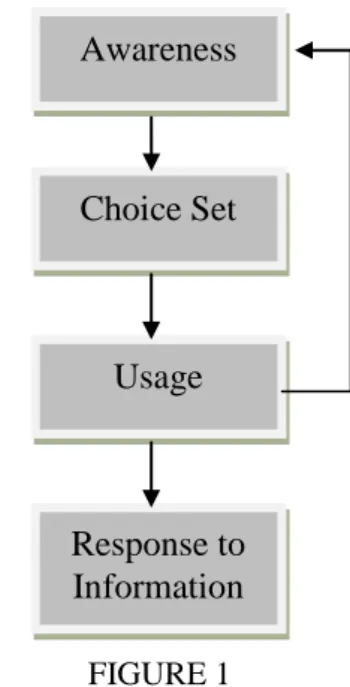
REGIONAL AIRPORTS AND LOCAL DEVELOPMENT
THE CHALLENGING BALANCE BETWEEN SUSTAINABILITY AND ECONOMIC GROWTH
